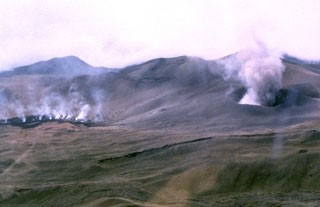Report on Cameroon (Cameroon) — March 1995
Bulletin of the Global Volcanism Network, vol. 20, no. 3 (March 1995)
Managing Editor: Richard Wunderman.
Cameroon (Cameroon) Seismicity in 1994 declines from 1993 levels
Please cite this report as:
Global Volcanism Program, 1995. Report on Cameroon (Cameroon) (Wunderman, R., ed.). Bulletin of the Global Volcanism Network, 20:3. Smithsonian Institution. https://doi.org/10.5479/si.GVP.BGVN199503-224010
Cameroon
Cameroon
4.203°N, 9.17°E; summit elev. 4095 m
All times are local (unless otherwise noted)
Overall seismic activity was lower in 1994 (240 total events) compared to 1993 (840 events). Most of the 1993 activity was from beneath the SE flank. The monthly number of events was consistently below 30 after October 1993, until December 1994 (figure 1). During 10-12 December a swarm of >40 microearthquakes with a maximum magnitude of 2.5 was recorded at station KBC. Because that was the only operational station, the events could not be accurately located. However, based on the waveform and S-P intervals of ~7 seconds, they were interpreted to be from Mount Cameroon. As of the end of January 1995, seismicity below the SE flank had returned to the 1992 level of 9-12 events/month.
Geological Summary. Mount Cameroon, one of Africa's largest volcanoes, rises above the coast of west Cameroon. The massive steep-sided volcano of dominantly basaltic-to-trachybasaltic composition forms a volcanic horst constructed above a basement of Precambrian metamorphic rocks covered with Cretaceous to Quaternary sediments. More than 100 small cinder cones, often fissure-controlled parallel to the long axis of the 1400 km3 edifice, occur on the flanks and surrounding lowlands. A large satellitic peak, Etinde (also known as Little Cameroon), is located on the S flank near the coast. Historical activity was first observed in the 5th century BCE by the Carthaginian navigator Hannon. During historical time, moderate explosive and effusive eruptions have occurred from both summit and flank vents. A 1922 SW-flank eruption produced a lava flow that reached the Atlantic coast, and a lava flow from a 1999 south-flank eruption stopped only 200 m from the sea. Explosive activity from two vents on the upper SE flank was reported in May 2000.
Information Contacts: A. Bekoa and N. Nfomou, ARGV, Buea; Ekodeck G.E. and N. Metuk, IRGM, Yaounde; J. Fairhead, Univ of Leeds.

